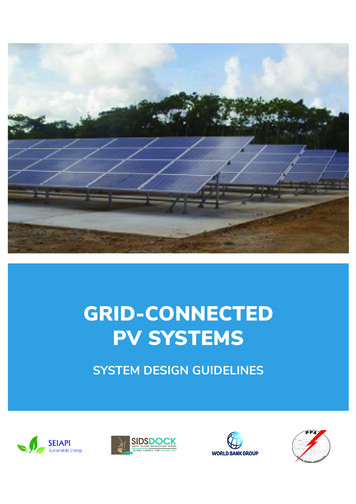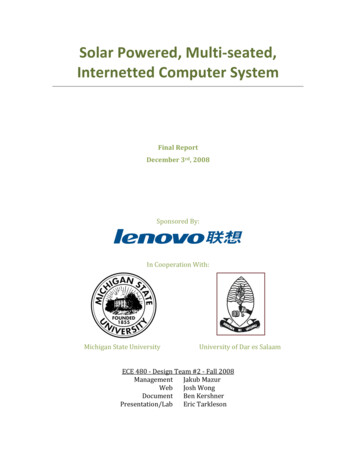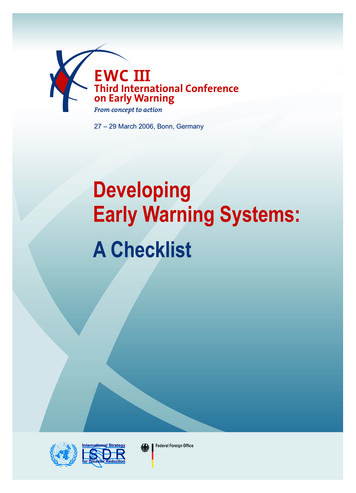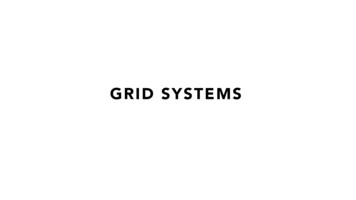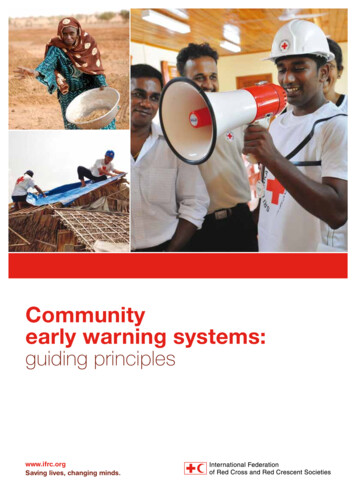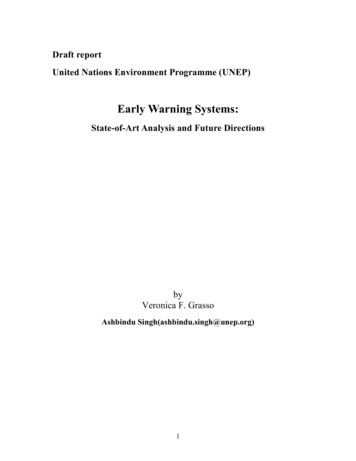
Transcription
Draft reportUnited Nations Environment Programme (UNEP)Early Warning Systems:State-of-Art Analysis and Future DirectionsbyVeronica F. GrassoAshbindu Singh(ashbindu.singh@unep.org)1
Table of ContentsEarly Warning Systems: . 1State-of-Art Analysis and Future Directions . 1Table of Contents. 2Chapter 1: Introduction. 3Early Warning. 3Types of Hazards . 4Early warning systems: operational aspects . 6Communication of early warning information . 9Early warning systems and policy . 10Chapter 2: Role of Earth Observation . 12Chapter 3: Inventory of early warning systems. 18Ongoing and Rapid/sudden-onset threats . 19Chemical and Nuclear Accidents. 19Wildland Fires . 19Geological Hazards. 20Earthquakes. 20Tsunamis. 21Volcanic Eruptions . 22Landslides . 23Hydro-Meteorological Hazards (except droughts) . 23Floods . 23Severe Weather, Storms and Tropical Cyclones . 24Epidemics . 25Slow-onset (or “creeping”) threats . 26Air Quality . 26Desertification. 27Droughts . 27Impact of Climate Variability. 28Food Insecurity . 29Chapter 4: Conclusions and Future Perspectives. 30Early Warning Systems: Current gaps and needs. 30Early Warning Systems: Future perspectives . 30State-of-art of existing multi-hazard global monitoring/early warning systems . 31Conclusions and recommendations . 34References. 37Acronyms. 39Appendix. 422
Chapter 1: IntroductionAt a time of global changes, the world is striving to face and adapt to inevitable, possibly profound,alteration. Widening of droughts in southern Europe and sub-Saharan Africa, an increasing number ofnatural disasters severe and more frequent flooding that could imperil low-lying islands and thecrowded river deltas of southern Asia, are already taking place and climate change will causeadditional environmental stresses and societal crises in regions already vulnerable to natural hazards,poverty and conflicts.A state-of-art assessment of existing monitoring/early warning systems (EWS) organized according totype of environmental threats is presented below. This report will focus on: air quality, wildland fires,nuclear and chemical accidents, geological hazards (earthquakes, tsunamis, volcanic eruptions,landslides), hydro-meteorological hazards (desertification, droughts, floods, impact of climatevariability, severe weather, storms, and tropical cyclones), epidemics and food insecurity. Current gapsand needs are identified with the goal of laying out guidelines for developing a global multi-hazardearly warning system.Chapter 1 introduces the basic concepts of early warning systems; Chapter 2 introduces the role ofearth observation for disasters and environment; Chapter 3 focuses on the existing earlywarning/monitoring systems; and Chapter 4 presents a global multi-hazard approach to early warning.Early WarningEarly warning (EW) is “the provision of timely and effective information, through identifiedinstitutions, that allows individuals exposed to hazard to take action to avoid or reduce their risk andprepare for effective response.”, and is the integration of four main elements, (from InternationalStrategy for Disaster Reduction (ISDR), United Nations (UN), 2006):1. Risk Knowledge: Risk assessment provides essential information to set priorities for mitigationand prevention strategies and designing early warning systems.2. Monitoring and Predicting: Systems with monitoring and predicting capabilities provide timelyestimates of the potential risk faced by communities, economies and the environment.3. Disseminating Information: Communication systems are needed for delivering warningmessages to the potentially affected locations to alert local and regional governmental agencies.The messages need to be reliable, synthetic and simple to be understood by authorities andpublic.4. Response: Coordination, good governance and appropriate action plans are a key point ineffective early warning. Likewise, public awareness and education are critical aspects ofdisaster mitigation.Failure of any part of the system will imply failure of the whole system.3
For example, accurate warnings will have no impact if the population is not prepared or if the alerts arereceived but not disseminated by the agencies receiving the messages.The basic idea behind early warning is that the earlier and more accurately we are able to predict shortand long-term potential risks associated with natural and human-induced hazards, the more likely wewill be able to manage and mitigate disasters’ impact on society, economies, and environment.Types of HazardsHazards can be associated with two types of events: ongoing and rapid/sudden-onset threats and slowonset (or “creeping”) threats.1. Ongoing and Rapid/sudden-onset: These would include such hazards as: accidental oil spills,nuclear plant failures, and chemical plant accidents — such as inadvertent chemical releases to theair or into rivers and water bodies geological hazards and hydro-meteorological hazards (exceptdroughts).2. Slow-onset (or “creeping”): Incremental but long-term and cumulative environmental changesthat usually receive little attention in their early phases but which, over time, may cause seriouscrises. These would include such issues as: air and water quality, soil pollution, acid rain, climatechange, desertification processes (including soil erosion and land degradation), droughts,ecosystems change, deforestation and forest fragmentation, loss of biodiversity and habitats,nitrogen overloading, radioactive waste, coastal erosion, pressures on living marine resources,rapid and unplanned urban growth, environment and health (emerging and re-emerging infectiousdiseases and links to environmental change), land cover/land changes, environment and conflict,among others. Such creeping changes are often left unaddressed as policymakers choose or need tocope with immediate crises. Eventually, neglected creeping changes may become urgent crises thatare more costly to deal with. Slow-onset threats can be classified into location specificenvironmental threats, new emerging science and contemporary environmental threats (see Table1.).Note that Rapid/sudden-onset hazards include geological threats such as earthquakes, volcaniceruptions, mudslides, and tsunamis. From a scientific point of view, geological events are the result ofincremental environmental processes but it may be more effective refer to them as quick onset. Most ofthe hydro-meteorological hazards (as floods, tornadoes, storms, heat waves, etc.) may be consideredrapid/sudden-onset hazards (type 1) but droughts are considered slow-onset (or “creeping”) hazards(type 2).Rapid/sudden-onset and slow-onset events will provide different amounts of available warning time.Early Warning systems may provide seconds to months of available warning time for earthquakes todroughts, respectively, which are the quickest and slowest onset hazards. Fig. 1 shows warning timesfor climatic hazards.In particular, early warning systems provide tens of seconds of warning for earthquakes, days to hoursfor volcanic eruptions, and hours for tsunamis. Tornado warnings provide minutes of lead-time forresponse. Hurricane warning time varies from weeks to hours.4
Warning time, provided by warning systems, increases to years or even decades of lead-time availablefor slow-onset threats (as El Nino, global warming etc. in Fig. 1). Drought warning time is in the rangeof months to weeks.Slow-onset (or creeping) changes may cause serious problems to environment and society, ifpreventive measures are not taken when needed. Such creeping environmental changes requireeffective early warning technologies due to the high potential impact of incremental cumulativechanges on society and environment.Table 1. Types of Environmental Threats1. Ongoing andRapid/sudden-onsetthreatsTypes of Environmental Threatsi.e. oil spills, nuclear plant failures, and chemical plant accidents,geological hazards and hydro-meteorological hazards-exceptdroughts.2. Slow-onset (or“creeping”) threatsi.e. air and water quality, soil pollution, acid rain, climate change,droughts, ecosystems change, loss of biodiversity and habitats, landcover/land changes, nitrogen overloading, radioactive waste, coastalerosion, etc.2.1 Location specificenvironmental threatsi.e. ecosystems changes, urban growth, transboundary pollutants, lossof wetlands etc.2.2 New emerging sciencei.e. associated with biofuels, nanotechnology, carbon cycle, climatechange, etc2.3 Contemporaryenvironmental threatsi.e. E-waste, bottled water, etc5
Figure 1 How early is early warning. (Golnaraghi M., 2005). The graph shows timeliness of early warning systemsfor hydro-meteorological hazards and area of impact (by specifying the diameter of the spherical area) for climatichazards.Early warning systems: operational aspectsEarly warning systems help to reduce economic losses and mitigate the number of injuries or deathsfrom a disaster, by providing information that allows individuals and communities to protect their livesand property. Early warning information empowers people to take action when a disaster close tohappening. If well integrated with risk assessment studies and communication and action plans, earlywarning systems can lead to substantive benefits.Is essential to note that “predictions are not useful, however, unless they are translated into a warningand action plan the public can understand and unless the information reaches the public in a timelymanner” (Glantz, 2003). Effective early warning systems embrace all aspects of emergencymanagement, such as: risk assessment analysis, which is one of early warning system’s designrequirements; monitoring and predicting location and intensity of the natural disaster waiting tohappen; communicating alerts to authorities and to potentially affected; and responding to the disaster.All aspects have to be addressed by the early warning system. Commonly, early warning systems lackof one or more elements. In fact, the review of existing early warning systems shows that in most casescommunication systems and adequate response plans are lacking.Monitoring and predicting is only one part of the early warning process. This step provides the inputinformation for the early warning process that needs to be disseminated to those whose responsibilityis to respond (Figure 2). Monitoring and predicting systems, if associated with communication systemand response plans, can then be considered early warning systems (Glantz, 2003).Early warnings may be disseminated to targeted users (local early warning applications) or broadly tocommunities, regions or to media (regional or global early warning applications).6
This information gives the possibility of taking action to initiate mitigation or security measures beforea catastrophic event occurs. The main goal of early warning systems is to take action to protect orreduce loss of life or to mitigate damage and economic loss, before the disaster occurs.Nevertheless, to be effective this warning must be timely so as to provide enough lead-time forresponding, reliable so that those responsible for responding to the warning will feel confident takingaction, and simple so as to be understood.Timeliness is often in conflict with the desire to have reliable predictions, which become more accurateas more observations are collected from the monitoring system (Grasso V. F., 2007). There is thereforean inevitable trade-off between the amount of warning time available and the reliability of thepredictions provided by the EWS. An initial alert signal may be sent to give the maximum amount ofwarning time when a minimum level of prediction accuracy has been reached. However, the predictionaccuracy for the location and size of the event will continue to improve as more data is collected by themonitoring system part of the EWS network. It must be understood that every prediction, being aprediction, is associated with uncertainty. Because of the uncertainties associated with the predictedparameters that characterize the incoming disaster, it is possible that a wrong decision may be made. Inmaking this decision, two kinds of wrong decisions may occur (Grasso V. F., 2007): Missed Alarm (orFalse Negative) when the mitigation action is not taken when it should have been or False Alarm (orFalse Positive) when the mitigation action is taken when it should not have been.Finally the message should at the same time communicate the level of uncertainty and expected cost oftaking action but also be simple so as to be understood by those who receive it. Most often, there is acommunication gap between EW specialists who use technical and engineering language and the EWSusers, who are generally outside of the scientific community. To avoid this, these early warnings needto be reported concisely, in layman’s terms and without scientific jargon.Figure 2 Early Warning System operational aspects7
EWS: decision making procedure based on cost-benefit analysisFor an improved performance of EWS, a performance-based decision making procedure needs to bebased on expected consequences of taking action, in terms of probability of false and missed alarm.An innovative approach sets the threshold based on the acceptable probability of false (missed)alarms, from a cost-benefit analysis (Grasso V. F., 2007).Consider the case of a EWS decision making strategy based on raising the alarm if a critical severitylevel, a, is predicted to be exceeded at a site. The decision of whether to activate the alarm or not isbased on the predicted severity of the event.A decision model that takes into account the uncertainty of the prediction and the consequences oftaking action will be capable of controlling and reducing false and missed alerts incidence. Theproposed decision making procedure intends to fill this gap. The EWS will provide to the user a real. During the course of the event, thetime prediction of the severity of the event, , and its error,increase of data available will produce an improvement of the prediction accuracy. The prediction andits uncertainty are updated as more data come in. The actual severity of the event, , is unknown andto the predicted value, .may be defined by adding the prediction error,The potential probability of false (missed) alarm is given by the probability of being less (greater)than the critical threshold, it becomes an actual probability of false (missed) alarm if the alarm is (not)raised:(1)(2)Referring to the principle of maximum entropy (Jaynes E.T., 2003), the prediction error is beingmodeled by Gaussian distribution, representing the most uninformative distribution possible due tolack of information. Hence, at time t, the actual severity of the event, , may be modeled with aGaussian distribution, having mean equal to the predictionand uncertainty equal to, that isthe standard deviation of the prediction error. Eq. (1) and (2) may be written as (Grasso V.F. etal., 2007):(3)(4)whererepresents the Gaussian cumulative distribution function. The tolerable level at whichmitigation action should be taken can be determined from a cost-benefit analysis by minimizing thecost of taking action:(5)8
where Csave are the savings due to mitigation actions and Cfa is the cost of false alert. Note that thetolerable levels and sum up to one which directly exhibits the trade-off between the thresholdprobabilities that are tolerable for false and missed alarms. The methodology offers an effectiveapproach for decision making under uncertainty focusing on user requirements in terms of reliabilityand cost of action.Communication of early warning informationAn effective early warning system needs an effective communication system.Early warning communication systems are made of two main components (EWCII, 2003): communication infrastructure hardware that must be reliable and robust, especially during thenatural disasters; andappropriate and effective interactions among the main actors of the early warning process suchas the scientific community, stakeholders, decision makers, the public, and the media.Many communication tools are currently available for warning dissemination such as Short MessageService (SMS) (cellular phone text messaging), email, radio, TV, and web service. Information andcommunication technology (ICT) is a key element in early warning. ICT plays an important role indisaster communication and dissemination of information to organizations in charge of responding towarnings and to the public during and after a disaster (Tubtiang, 2005).Redundancy of communication systems is essential for disaster management, while emergency powersupplies and back-up systems are critical in order to avoid the collapse of communication systems afterdisasters occur.In addition, in order to ensure reliable and effective operation of the communication systems duringand after disaster occurrence, and to avoid network congestion, frequencies and channels must bereserved and dedicated to disaster relief operations.Nowadays, an extreme decentralization of information and data through the World Wide Web makes itpossible for millions of people worldwide to have easy, instantaneous access to a vast amount ofdiverse online information. This powerful communication medium has spread rapidly to interconnectour world, enabling near-real-time communications and data exchanges worldwide. According to theInternet World Stats database, as of November 2007, global documented Internet usage was 1.3 billionpeople. Thus, the Internet has become an important medium to access and deliver informationworldwide in a very timely fashion.In addition, remote sensing satellites now provide a continuous stream of data. They are capable ofrapid and effective detection of hazards such as transboundary air pollutants, wildfires, deforestation,changes in water levels, and natural hazards. With rapid advances in data collection, analysis,visualization and dissemination, including technologies such as remote sensing, GeographicalInformation Systems (GIS), web mapping, sensor webs, telecommunications and ever growing Internetconnectivity, it is now feasible to deliver relevant information on a regular basis to a worldwideaudience relatively inexpensively. In recent years, commercial companies such as Google, Yahoo, andMicrosoft have started incorporating maps and satellite imagery into their products and services,delivering compelling visualization and providing easy tools that everyone can use to add to theirgeographic knowledge.9
Information is now available in a near-real-time mode from a variety of sources at global and locallevels. In coming years, the multi-scaled global information network will greatly improve thanks tonew technological advances facilitating the global distribution of data and information at all levels.Globalization and rapid communication provides an unprecedented opportunity to catalyze effectiveaction at every level by rapidly providing authorities and general public with high-quality,scientifically credible information in a timely fashion.Dissemination of warnings often follows a cascade process, which starts at international or nationallevel and then moves outwards or downwards in the scale, reaching regional and community levels(Twigg J., 2003). Early warnings may activate other early warnings at different authoritative levels,flowing down in responsibility roles, but all are equally necessary for effective early warning.Standard protocols play a fundamental role in addressing the challenge of effective coordination anddata exchange among the actors in the early warning process and it aids in the the process for warningcommunication and dissemination. The Common Alerting Protocol (CAP), Really Simple Syndication(RSS) and Extensible Markup Language (XML) are examples of standard data interchange formats forstructured information that can be applied to warning messages for a broad range of informationmanagement and warning dissemination systems.The advantage of standard format alerts is that they are compatible with all information systems,warning systems, media, and most importantly, with new technologies such as web services.CAP defines a single standard message format for all hazards, which can activate multiple warningsystems at the same time and with a single input. This guarantees consistency of warning messages andwould easily replace specific application-oriented messages with a single multi-hazard messageformat. CAP is compatible with all types of information systems and public alerting systems (includingbroadcast radio and television), public and private data networks, multi-lingual warning systems andemerging technologies such as Internet Web services, and existing systems such as the U.S. NationalEmergency Alert System and the National Oceanic and Atmospheric Organization (NOAA) WeatherRadio. CAP uses Extensible Markup Language (XML) language. It contains information about thealert message, the specific hazard event, and appropriate responses, including urgency of action to betaken, severity of the event, and certainty of the information.Early warning systems and policyFor early warning systems to be effective, it is essential that they be integrated into policies for disastermitigation.Good governance priorities include protecting the public from disasters through the implementation ofdisaster risk reduction policies.It is clear that natural phenomena cannot be prevented, but their human, socio-economic andenvironmental impacts can and should be minimized through appropriate measures, including risk andvulnerability reduction strategies, early warning, and appropriate action plans. Most often, theseproblems are given attention during or immediately after a disaster. Disaster risk reduction measures10
require long term plans and early warning should be seen as a strategy to effectively reduce thegrowing vulnerability of communities and assets.The information provided by early warning systems enables authorities and institutions at variouslevels to immediately and effectively respond to a disaster.It is crucial that local government, local institutions, and communities be involved in the entire policymaking process, so they are fully aware and prepared to respond with short and long-term action plans.The early warning process, as previously described, is composed of 4 main stages: risk assessment,monitoring and predicting, disseminating and communicating warnings, and response. Within thisframework, the first phase, when short- and long-term actions plans are laid out based on riskassessment analysis, is the realm of institutional and political actors. Then EW acquires technicaldimension in the monitoring and predicting phase, while in the communication phase EW involvesboth technical and institutional responsibility. The response phase then involves many more sectors,such as national and local institutions, non-governmental organizations, communities, and individuals.Below is a summary of recommendations for effective decision-making within the early warningprocess (Sarevitz D. et al., 2000):Prediction is insufficient for effective decision-making. Prediction efforts by the scientificcommunity alone are insufficient for decision-making. The scientific community and policy-makersshould outline the strategy for effective and timely decision-making by indicating what information isneeded by decision-makers, how predictions will be used, how reliable the prediction must be toproduce an effective response, and how to communicate this information and the tolerable predictionuncertainty so that the information can be received and understood by authorities and public.A miscommunicated or misused prediction can result in costs to the society. Prediction,communication, and use of the information are necessary factors in effective decision-making withinthe early warning process.Develop effective communication strategies. Wishing not to appear ‘alarmist’ or to avoid criticism,local and national governments have sometimes kept the public in the dark when receiving technicalinformation regarding imminent threats. The lack of clear and easy-to-use information can sometimesconfuse people and undermine their confidence in public officials. Conversely, there are quite a fewcases where the public may have refused to respond to early warnings from authorities, and havetherefore exposed themselves to danger or forced governments to impose removal measures. In anycase, clear and balanced information is critical, even when some level of uncertainty remains. For thisreason uncertainty level of the information must be communicated to users together with early warning(Grasso V. F. et al., 2007).Establish proper priorities. Resources must be allocated wisely and priorities should be set, based onrisk assessment analysis, for long- and short-term decision-making, such as investing in local earlywarning systems, education, or enhanced monitoring and observational systems. On the other hand,decision-makers need to be able to set priorities for timely and effective response to a disaster when itoccurs based on the information received from the early warning system. Decision-makers shouldreceive necessary training on how to use the information received when an alert is issued and what thatinformation means.11
Clarify responsibilities. Institutional networks should be developed with clear responsibilities.Complex problems such as disaster mitigation and response require multi-disciplinary research, multisector policy and planning, multi-stakeholder participation, and networking involving all theparticipants of the process such as the scientific research community (including social sciencesaspects), land use planning, environment, finance, development, education, health, energy,communications, transportation, labor, and social security as well as natio
This information gives the possibility of taking action to initiate mitigation or security measures before a catastrophic event occurs. The main goal of early warning systems is to take action to protect or reduce loss of life or to mitig

